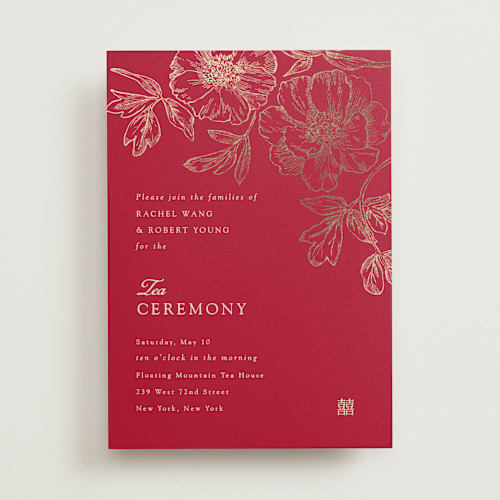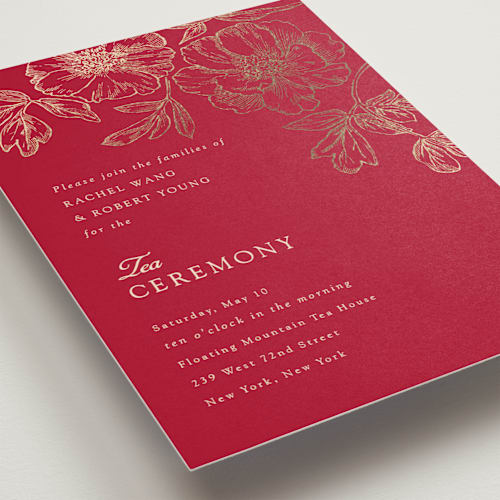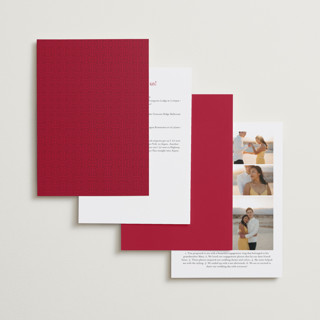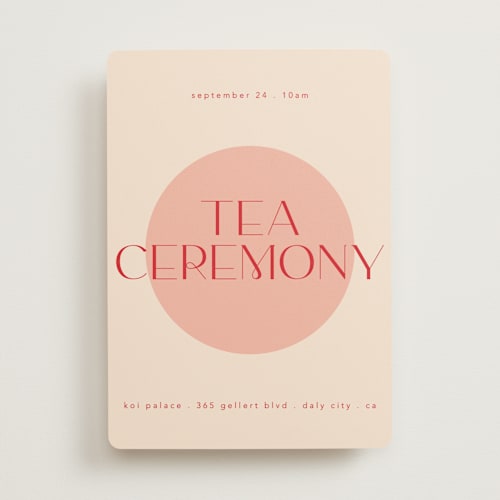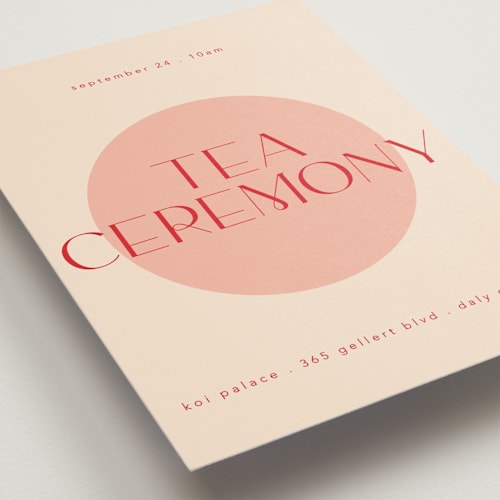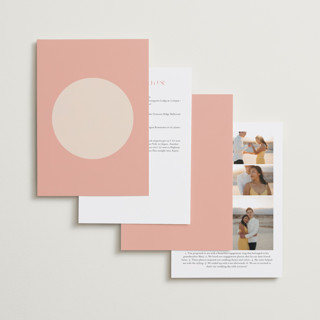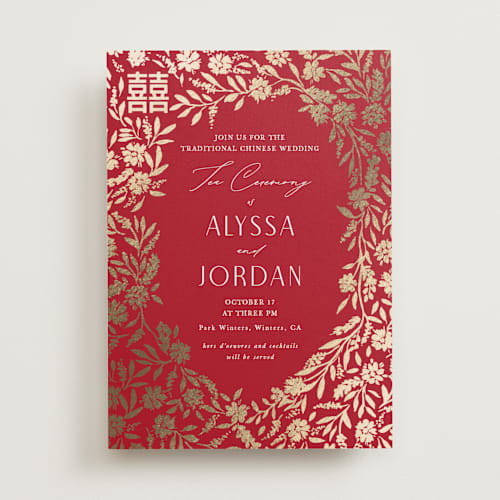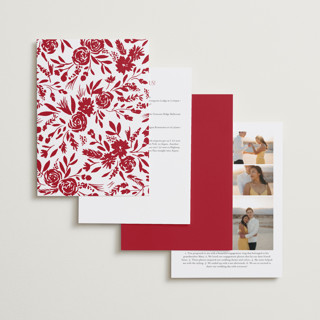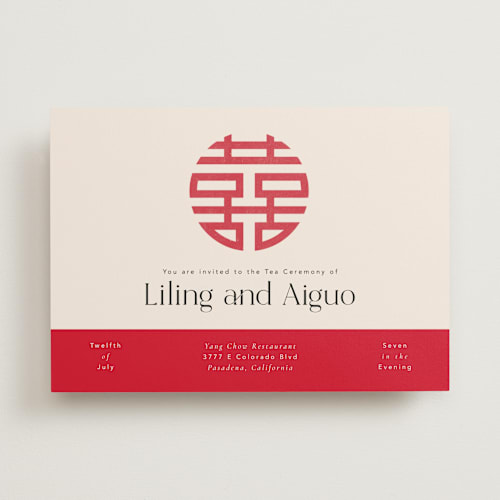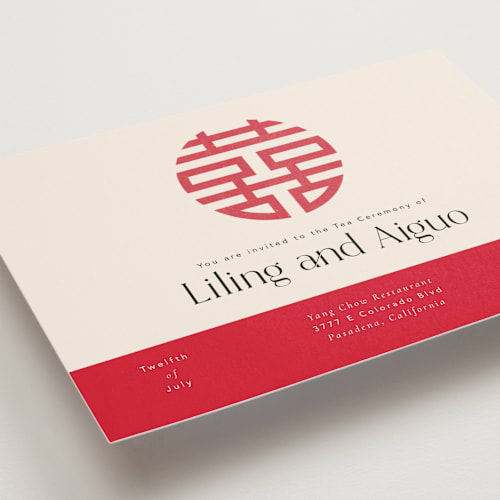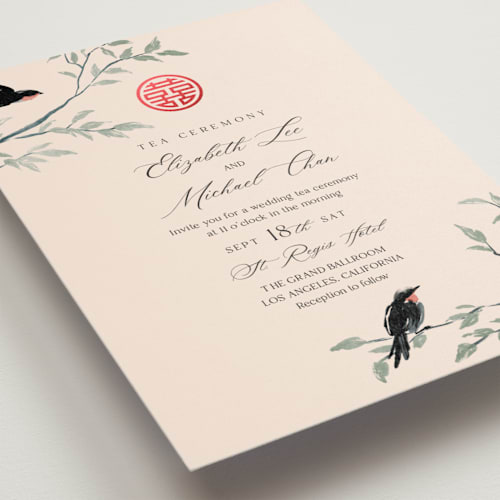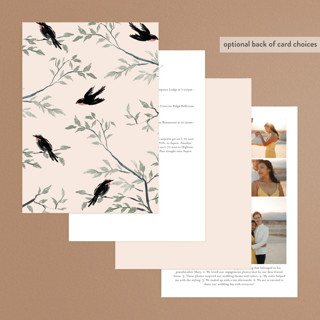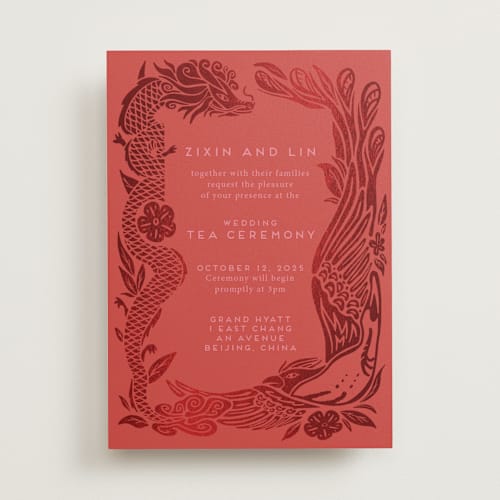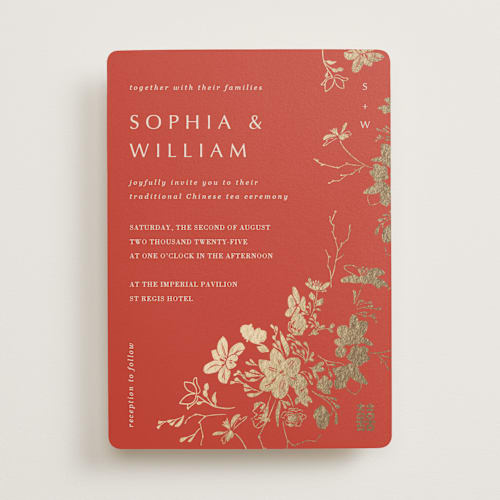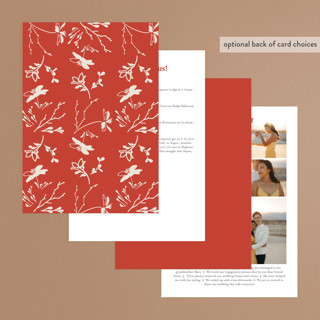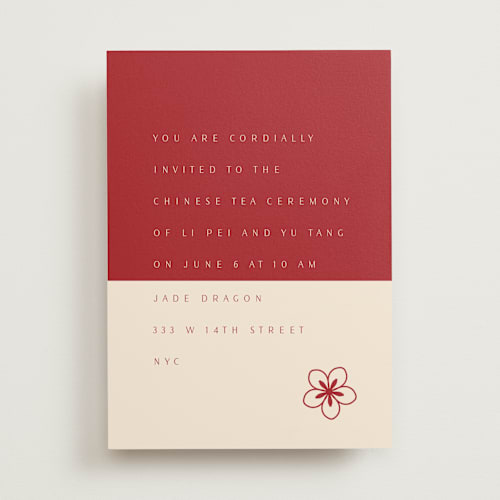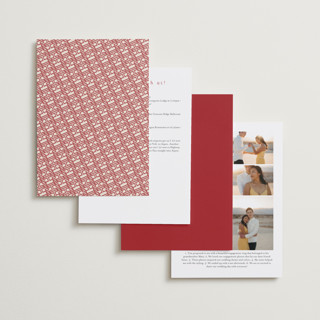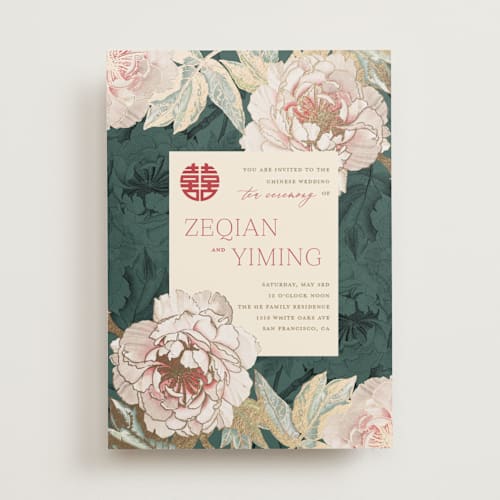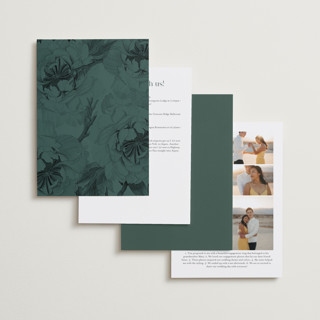The Significance of Wedding Tea Ceremony
If you are looking to honor your Chinese heritage and culture on your big day, the tea ceremony is a Chinese wedding tradition that you should definitely consider. Dating back more than 1,000 years, the tea ceremony represents the union of the couple’s families, and is a chance for the bride and groom to show respect to their elders by serving them tea. As with any wedding tradition, Chinese wedding tea ceremonies come with special etiquette and invitation considerations. Here’s what you need to know.
Traditional Elements of Wedding Tea Ceremonies
When it comes to the color palette, symbols, and decor of tea ceremonies, the traditions of Chinese wedding celebrations hold true. Look for stationery and decor in rich red and gold hues, and don’t shy away from dramatic uses of the double happiness symbol or dragon and phoenix iconography.
- Red & Gold Color Palette. Tea ceremony invitations should feature a red and gold color palette that matches the rest of the wedding invitation suite, as these two colors symbolize prosperity and happiness in marriage. Couples will often also opt to wear red, kneel on decorative red cushions, and use a red tea set during the ceremony.
- Double Happiness Symbol. The double happiness symbol— 囍 —is another element that should be included on the tea ceremony invitation and invitation envelope (if you are sending the tea ceremony invitation separate from the wedding invitation). This symbol means joy and happiness, and is used to represent the double joy of the newlyweds. For this reason, many couples choose to use cushions embroidered with 囍 during the tea ceremony as well.
- Dragon and Phoenix Illustrations. In modern Chinese weddings, dragons are commonly used to symbolize the strength and wealth of the groom, while the bride is represented by the phoenix. During the tea ceremony, couples will light two candles—one with a dragon design and the other with a phoenix design—to represent each of their families.
- Gold Jewelry. It is common for brides to wear gold jewelry on their wedding day, and this jewelry is typically presented as a gift to the bride at the tea ceremony.
- Red Envelopes. In addition to jewelry, the bride and groom typically also receive red envelopes—紅包—filled with money or gold from their elders. Because wedding gifts are not traditionally given in Chinese weddings, this is a way for the couple’s family to bless the couple and set them up for a prosperous marriage.
Wedding Tea Ceremony Invitation FAQ
When do you host the tea ceremony?
The tea ceremony is almost always hosted on the same day as the wedding. This is because the tea ceremony is where the families’ welcome the bride or groom into their family, and the completion of the ceremony is a sign of marriage in Chinese tradition. It is also where couples will usually sign Chinese marriage licenses.
Exactly when you choose to host your tea ceremony on your wedding day can depend on many things. Many couples consult a Chinese almanac or Feng Shui specialist to understand when the most auspicious hour of their wedding day will take place. They will then choose to host their tea ceremony at that time, whether it be before or after the wedding ceremony.
Other couples will let how private they want their tea ceremony to be determine its timing. If they want to keep things more intimate, they may choose to host the tea ceremony with just their family before the wedding. Or, if they’d like all of their guests to witness the ceremony, they may choose to host it at cocktail hour.
Who is invited to the tea ceremony?
Traditionally, tea ceremonies are a more intimate part of the wedding day, with parents, grandparents, and close family members of the couple in attendance. Bridesmaids may also be invited to help serve the tea.
That said, some couples choose to extend the invitation to all of their wedding guests, especially if they are hosting a smaller wedding. If you plan to invite everyone to the tea ceremony portion of the day, be sure to provide enough information for guests unfamiliar with the significance of the ceremony to allow them to follow along respectfully. Your wedding website is a great place to provide additional information about the significance behind the various traditions you plan to include on your big day.
Where is the tea ceremony hosted?
Traditionally, couples would host two tea ceremonies: one with the bride’s family in their home, and the other with the groom’s family in their home. While this is still done today, it is also common to host a single tea ceremony for both families in one home or location.
If you plan to invite all of your guests to your tea ceremony, then you will likely need to find a separate space to host it (you don’t want everyone crowding into your living room, after all!). A quiet outdoor courtyard at your wedding venue or using an area of your cocktail hour space is a popular choice for couples hosting larger tea ceremonies.
What else do you need to prepare for the tea ceremony?
- Tea Types. Although any type of tea can be used during the tea ceremony, you can brew the tea with lotus seeds or red dates, as they symbolize fertility and good fortune, respectively.
- Serving Order. The parents of the couple are usually served first, followed by the grandparents and the rest of the extended family (uncles and aunts, elder siblings, elder cousins) in order of seniority. The groom’s family typically goes first followed by the bride’s, but you can also choose to alternate families between rounds. During the tea pouring, the family members should be seated on chairs while the bride and groom face the relative of their gender, kneeling on cushions. The father of the groom is served a cup of tea by the groom, and then by the bride; then themother of the groom is then served by the groom, and then by the bride (each person should receive two cups of tea). This same order is then used to serve the other relatives. When serving tea, couples should address each family member by their official title, and offer them the tea cup using both hands.
- Ceremony Length. There is no set length for the tea ceremony, as it can depend greatly on how many family members you plan to include. When planning the timeline for your big day, keep in mind that once the tea is served, the elder family members might share a short speech or words of wisdom while sipping the tea, as well as present gifts, including red envelopes containing cash for the couple and gold jewelry for the bride.
Chinese Tea Ceremony Invitation Suites
Because the tea ceremony is so closely linked to the events of the wedding day, it is common for couples to include an invitation to the tea ceremony within the invitation suites of the guests they plan to invite. Because of this, all of Minted’s Chinese wedding invitation designs feature a matching or complementary tea ceremony invitation.
That said, if you are looking to play with tradition by going for a more unique approach to your invitations, you can choose to mix and match the design of your tea ceremony invitation with the rest of your suite. A few fun ways to do this include:
- Play with paper colors. Even if you opt to match your tea ceremony invitation to your wedding invitation, you can choose to have it printed on a contrasting card stock to add a bit of interest to your invitation suite.
- Play with shape. You could also choose to add interest to your tea ceremony invitation by selecting a silhouette that contrasts with the main wedding invitation. Matching a scalloped-edge card with one with more traditional rounded corners is a fun way to make the different invitations stand apart from each other.
Wedding Invitation Customization
If you want every part of your big day to feel uniquely you, Minted provides custom design services to help couples design their invitation suites from scratch. Get started by filling out an initial request form outlining your vision and capturing your inspiration for your invitations. Then, you’ll get paired with one of our in-house designers that will work closely with you to bring your design to life. We offer unlimited rounds of revisions, so you can rest easy knowing that we’re working tirelessly to make your dream wedding a reality.




